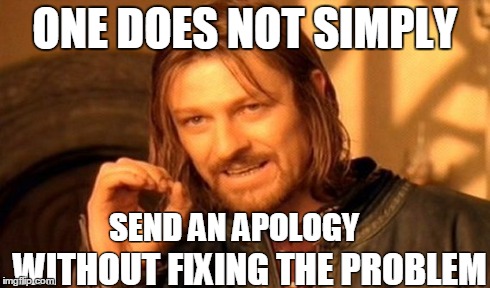
It is inherent to our job that we send an email or two. Everybody who sends email marketing messages regularly will have a moment when the campaign slips into an “Oops!” or “Doh!” moment.
Even if you test, test, test, tested your emails thoroughly, it is bound to happen sooner or later in your email career. We all make mistakes. Now, you might think we have outsourced our email marketing, and our email agency is full-service and taking care of it. Think again.
If we don’t make our mistakes ourselves, there is always someone else or a piece of technology to make them for us. Prevention is better than a cure, they say. So please avoid making mistakes in your newsletter as much as possible, but know there will be a time that Murphy’s law (everything that can go wrong will at some point) goes into effect.
Of course, in case of a mistake, you could sweat it out for the following days, hope for the best, and hope that it will blow over. But in most situations, that is a pretty risky strategy. It is best to step in and take control. There are several ways to handle “code red.” I outlined the steps to follow below.
Step 1: Can we limit the size of the problem?
It is always a good idea to try and keep the problem as small as possible, here are some ideas:
- If the newsletter hasn’t been sent out to all contacts yet: Pause or stop it so less people receive it.
- Can we fix the problem? Sometimes it is an easy fix to repair a landing page, link, or image that doesn’t display correctly. In that case, you are reducing the size of the problem too, limiting it to the people that acted or have seen your email before you fixed the problem and even without sending a second email.

In all cases the problem should be fixed before sending out the next e-mail. If the problem is on your site or landing page, think about pausing other scheduled newsletters and maybe even your email drip campaigns.
Step 2: Go social

Whatever the problem was, jump behind your social media dashboard, monitoring tools or ask your customer service to keep a close eye. Mistakes can quickly be blown out of proportion. Be social savvy and defuse any remarks and answer questions about it on popular social media channels like Twitter and Facebook before they spread. Of course the more serious the Oops, the more important the social customer service is. Which brings us to the next step…
Step 3: The 5 levels of Oops
Now we have to ask ourselves, how serious was the problem and does it justify sending an oops / apology e-mail? What can go wrong? Everything. Sent out a test-email by mistake? Sent an email with wrong products or pricing? Here are the 5 levels of Oops.
- Oops level Green: Mistakes the recipients will hardly notice or mind (e.g. minor spelling errors in your footer).
- Oops level Yellow: Something embarrassing or a small technical error (e.g. a broken image or wrong rendering).
- Oops level Orange: Missed revenue, darn! (site not available or links broken).
- Oops level Orange dash 2: Orange could also be a case of “mistaken identity” where you selected the wrong list to send to.
- Red Alert: Something that is definitely a big mistake and could end up losing clients forever or seriously damaging your brand.
But before you think about sending an apology, lets reduce the scale some more.
Step 4: Select your “Oh So Sorry” segment
The second containment area is in the number of apology emails, we only need to send a correction or apology to those subscribers that received the original faulty email.
- Limit your apology to those affected, so for instance if a link was broken, only send the apology to those that clicked on that particular link.
- If a wrong group was emailed, see if there is any overlap with the group it was intended for. Those in the overlapping selection don’t need an apology mail.
Step 5: Telling the story of Sorry
Making a great apology email is actually quite a chore, the wording should be precisely right and of course there is the time pressure (plus any possible problem there was would need to be solved). The message should be in tune with your audience and the mistake that was made. Otherwise, it might seem insincere and unauthentic and it might seem even opportunistic at times. In the next article I’ll give some examples of apology emails. Most would say to send out an apology as fast as you can, but don’t panic. Breathe in, breathe out. Panic only leads to rash decisions. Go through the normal quality checks you normally do. And go through the pre-launch email checklist before deploying your apology email.
The secret

You can also look on the bright side. Depending on the nature of the mistake, a well-placed apology mail might even outperform your normal email newsletter. It brings variety to your email program, something that breaks the mould and stands out. Should you make a mistake on purpose then? Well… if you do, it will be our little secret.
